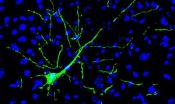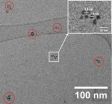(Press-News.org) MADISON, Wis. – As production of shale gas soars, the industry's effects on nature and wildlife remain largely unexplored, according to a study by a group of conservation biologists published in Frontiers in Ecology and the Environment on August 1.
The report emphasizes the need to determine the environmental impact of chemical contamination from spills, well-casing failure, and other accidents.
"We know very little about how shale gas production is affecting plants and wildlife," says author Sara Souther, a conservation fellow in the Department of Botany at the University of Wisconsin-Madison. "And in particular, there is a lack of accessible and reliable information on spills, wastewater disposal and the chemistry of fracturing fluids. Of the 24 U.S. states with active shale gas reservoirs, only five maintain public records of spills and accidents."
The 800 percent increase in U.S. shale gas production between 2007 and 2012 is largely due to the use of hydraulic fracturing. Also called fracking, the process uses high-pressure injection of water, laden with sand and a variety of chemicals, to open cracks in the gas reservoir so natural gas can flow to the well. A similar technique is used for extracting oil from "tight" geologic formations.
The chemical makeup of fracturing fluid and wastewater, which can include carcinogens and radioactive substances, is often unknown. The authors reviewed chemical disclosure statements for 150 wells in three top gas-producing states and found that, on average, two out of three wells were fractured with at least one undisclosed chemical.
Pressured by growing concern about pollution to groundwater and surface water, government and the industry have made some steps toward openness, Souther acknowledges, but she says more progress is needed.
"The Pennsylvania Department of Environmental Protection's website is one of the nation's best sources of publicly available information on spills of fracking fluid, wastewater, and other contaminants. Even so, gas companies failed to report over one third of spills in the last year," she says. "How many more unreported spills occurred, but were not detected during well inspections? We need accurate data on the release of fracturing chemicals into the environment before we can understand impacts to plants and animals."
One of the greatest threats to animal and plant life identified in the study is the cumulative impact of rapid, widespread shale development, with each individual well contributing collectively to air, water, noise and light pollution.
"The past has taught us that environmental impacts of large-scale development and resource extraction, whether coal plants, large dams or biofuel monocultures, are more than the sum of their parts," notes Morgan Tingley, a researcher from University of Connecticut. "We can't let shale development outpace our understanding of its environmental impacts."
"If you look down on a heavily fracked landscape," Souther says, "you see a web of well pads, access roads, and pipelines creating islands out of what was, in some cases, continuous habitat. What are the combined effects of numerous wells and their supporting infrastructure on wide-ranging or sensitive species, like the pronghorn antelope or the hellbender salamander?
"I am from West Virginia, which is underlain by one of the largest shale gas reservoirs in the U.S. However, this industry doesn't just impact gas-producing states. Here in Wisconsin, shale development is affecting areas that supply sand for use in hydraulic fracturing."
The study looked broadly at what is known — and what is not — about the conservation impacts of fracking. "Some of the wells in the chemical disclosure registry were fractured with fluid containing 20 or more undisclosed chemicals," says co-author Kimberly Terrell, a researcher at the Smithsonian Conservation Biology Institute. "This is an arbitrary and inconsistent standard of chemical disclosure."
With shale gas production projected to increase exponentially over the next 30 years, the authors hope the study will guide the application of limited scientific resources to the most important questions, and enhance cooperation among scientists, industry and policymakers to minimize damage to the natural world.
INFORMATION:
The authors are all David H. Smith Conservation Research Fellows, a project established by the Cedar Tree Foundation and the Society for Conservation Biology. Souther has been a research fellow at UW-Madison for three years. In September, she will begin a professorship at West Virginia Wesleyan College in West Virginia.
David Tenenbaum, 608-265-8549, djtenenb@wisc.edu
Drilling in the dark: Biological impacts of fracking still largely unknown
2014-08-04
ELSE PRESS RELEASES FROM THIS DATE:
New insights into why adolescents carry meningitis-causing bacteria
2014-08-04
University of York scientists have shed new light on why teenagers and young adults are particularly susceptible to meningitis and septicaemia.
The team from the University's Department of Biology has discovered a novel metabolic pathway in the bacterium Neisseria meningitidis that may explain why this age group is particularly at risk of infection.
The results of the research, which was supported by the Centre for Chronic Diseases and Disorders (C2D2), are reported in the journal Molecular Microbiology.
N. meningitidis is a major cause of meningitis and septicaemia, ...
Researchers find potential new predictor of stress-related illnesses
2014-08-04
SAN ANTONIO (Aug. 2, 2014) ― Scientists studying depression in teens have discovered that subtle changes in a gene can predict how the brain reacts to stress, which can cause such health issues as depression, post-traumatic stress disorder and obesity.
The research, published Aug. 2 in the journal Nature, focuses on two longitudinal studies led by Douglas E. Williamson, Ph.D., from The University of Texas Health Science Center at San Antonio, and Ahmad Hariri, Ph.D., from Duke University. Scientists from Columbia University and the University of Pittsburgh are ...
Key adjustment enables parasite shape-shifting
2014-08-04
VIDEO:
Researchers show that suppressing expression of a key protein causes major changes in the shape of T. brucei (shown here), the parasite that causes African sleeping sickness.
Click here for more information.
Crafty parasites frequently undergo dramatic shape changes during their life cycles that enable them to adapt to different living conditions and thrive. But these transformations might not be as difficult as they appear, according to a study in The Journal of Cell Biology.
African ...
It's not rocket science. Oh wait, it is
2014-08-04
WASHINGTON, August 4, 2014 — This week, Reactions is blasting off with an episode that's all about rockets. Featuring Doane College Postdoctoral Fellow Raychelle Burks, Ph.D., we examine the chemistry of solid and liquid propellants, orbital maneuvering and the "ride-able explosion" that is a rocket launch. You can "launch" the video at: https://www.youtube.com/watch?v=Yqiq2lQrqGI.
INFORMATION:
Subscribe to the series at Reactions YouTube, and follow us on Twitter @ACSreactions to be the first to see our latest videos.
The American Chemical Society is a nonprofit ...
NASA sees Tropical Storm Bertha leaving the Bahamas
2014-08-04
Tropical Storm Bertha took a "vacation" in the Bahamas on August 3 and NASA's Terra satellite captured an image of the storm that appeared be centered over "Crooked Island."
On August 2, before Bertha visited the Bahamas, the western half of the storm passed over Puerto Rico. A visible image captured by NASA's Terra satellite showed Bertha's clouds stretched from Puerto Rico east, over the British Virgin Islands. NOAA's National Weather Service office in San Juan, Puerto Rico reported 1.36 inches of rainfall from Bertha on August 2.
On August 3 at 15:35 UTC (11:35 a.m. ...
New information on transcranial ultrasound therapy
2014-08-04
A recent study completed at the University of Eastern Finland provides new information on the limitations and potential new directions for the future development of transcranial ultrasound therapy. Active research is taking place in the field of transcranial ultrasound therapy, which in the future can potentially be applied to the treatment of brain tumours and targeted drug delivery. The therapy modality has already been successfully applied to the treatment of neuropathic pain disorder and essential tremors. The benefits of transcranial ultrasound therapy include minimal ...
Implanted Neurons become Part of the Brain
2014-08-04
Scientists at the Luxembourg Centre for Systems Biomedicine (LCSB) of the University of Luxembourg have grafted neurons reprogrammed from skin cells into the brains of mice for the first time with long-term stability. Six months after implantation, the neurons had become fully functionally integrated into the brain. This successful, because lastingly stable, implantation of neurons raises hope for future therapies that will replace sick neurons with healthy ones in the brains of Parkinson's disease patients, for example. The Luxembourg researchers published their results ...
Extracting audio from visual information
2014-08-04
Researchers at MIT, Microsoft, and Adobe have developed an algorithm that can reconstruct an audio signal by analyzing minute vibrations of objects depicted in video. In one set of experiments, they were able to recover intelligible speech from the vibrations of a potato-chip bag photographed from 15 feet away through soundproof glass.
In other experiments, they extracted useful audio signals from videos of aluminum foil, the surface of a glass of water, and even the leaves of a potted plant. The researchers will present their findings in a paper at this year's Siggraph, ...
A protecting umbrella against oxygen
2014-08-04
This news release is available in German.
In a paper published this week in the journal Nature Chemistry, researchers from the Center for Electrochemical Sciences – CES at the Ruhr-University Bochum and from the Max-Planck-Institute for Chemical Energy Conversion in Mülheim an der Ruhr report a novel concept to work with efficient and possibly cheaper catalysts. A kind of buffer protects the catalysts against the hostile conditions encountered in fuel cells, which have been to date dismissed utilization. The scientists report in the current issue of Nature Chemistry.
Hydrogenases, ...
Self-assembly of gold nanoparticles into small clusters
2014-08-04
This news release is available in German.
This was determined using Small-Angle X-ray Scattering (SAXS) at BESSY II. A thorough examination with an electron microscope (TEM) confirmed their result. "The research on this phenomenon is now proceeding because we are convinced that such nanoclusters lend themselves as catalysts, whether in fuel cells, in photocatalytic water splitting, or for other important reactions in chemical engineering", explains Dr. Armin Hoell of HZB. The results have just appeared in two peer reviewed international academic journals.
"What ...






